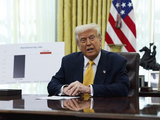Diverging Views on Palestinian Statehood; French Protests Highlight Economic Tensions; U.S.-China Dialogue; China’s Technological Advancements; NVIDIA’s Investment in Intel; AI’s Ascendancy
U.S.-UK-Israel Relations: Diverging Views on Palestinian Statehood
Recent events highlight the diverging positions between the United States and the United Kingdom regarding the recognition of a Palestinian state, a topic that has seen renewed diplomatic attention. Xinhua reports on U.S. President Trump's opposition to the UK's plan to recognize Palestine as a state. This opposition was articulated during his state visit to the UK, where he engaged in discussions with Prime Minister Sunak. The narrative emphasizes the geopolitical implications of such recognition, particularly in the context of rising tensions in the Gaza Strip.
Complementing this perspective, CCTV provides a similar account of President Trump's disapproval of the UK's intentions. The article highlights the strategic disagreements between the two allies, underscoring the broader implications for U.S. foreign policy and its allies. Additionally, the piece notes the collaborative signing of a "Technological Prosperity Agreement" focusing on AI, quantum computing, and nuclear technology, indicating areas of continued cooperation despite political differences.
These developments indicate a complex diplomatic landscape where strategic alliances are both challenged and reinforced. While Xinhua underscores the isolation of Israel with U.S. support, CCTV focuses on the technological collaboration, suggesting a dual narrative of conflict and cooperation. Both sources illustrate the intricate balance of power and diplomacy, with the UK’s potential recognition of Palestine serving as a contentious point in international relations.
French Protests Against Austerity Measures Highlight Economic Tensions
Recent events in France have brought to light significant public unrest against government austerity measures. According to Xinhua, over 500,000 people participated in strikes and demonstrations across France on September 18th, protesting against the government's fiscal tightening plans. The protests, which included violent incidents and arrests, were in response to measures proposed in the 2026 budget, such as changing public holidays to workdays and cutting healthcare spending, aimed at alleviating public debt pressures. The French Prime Minister expressed willingness to negotiate with unions and protestors, although he condemned the violence accompanying the demonstrations.
Similarly, United Daily News reported that the protests were driven by a demand for higher taxes on the wealthy to promote fiscal equity. The outlet highlighted the participation of diverse groups, including education, transportation, and healthcare workers, reflecting widespread discontent. The new Prime Minister's decision to abandon the cancellation of two national holidays and limit benefits for outgoing officials was noted as insufficient to quell public anger. The call for a 'Zucman tax,' a levy on the ultra-wealthy, was a focal point of the protests.
These developments indicate a unified public demand for economic justice and fair distribution of wealth, with both publications emphasizing the scale and intensity of the protests. While Xinhua focused on the immediate political response and security concerns, United Daily News delved into the socio-economic demands and ideological underpinnings of the protests. The differing narratives suggest varying editorial focuses, with Xinhua prioritizing governmental reaction and order, while United Daily News underscores economic inequality and grassroots activism.
Analysis of Recent U.S.-China Dialogue and Its Implications
The recent dialogues between U.S. President Joe Biden and Chinese President Xi Jinping have stirred significant attention across various media outlets, highlighting the complexities of U.S.-China relations. United Daily News reports that the conversation, scheduled for September 19, marks the first direct dialogue between the two leaders since June. The topics expected to be discussed include TikTok, rare earth elements, and Taiwan, reflecting ongoing tensions and strategic interests between the two nations.
In contrast, Liberty Times emphasizes the symbolic nature of the call, with a focus on Taiwan's strategic importance. The publication quotes a Kuomintang lawmaker who expresses skepticism about the potential outcomes of the dialogue, suggesting it may merely be a formality. This perspective highlights the persistent geopolitical tension surrounding Taiwan, a critical point of contention in U.S.-China relations.
Both articles underscore TikTok as a central issue, albeit with differing emphases. United Daily News suggests that a framework agreement on TikTok has been reached, yet questions remain about the long-term implications for TikTok's operations if it becomes an independent entity led by U.S. investors. This focus on the technical and operational aspects of TikTok reflects broader concerns about technology and data security in the bilateral relationship.
Meanwhile, Liberty Times frames the TikTok discussion within a broader strategic competition narrative, noting that the resolution of TikTok's issues could set a precedent for future trade and national security dialogues. This narrative aligns with the publication's focus on Taiwan, suggesting that the dialogue could influence broader policy directions in the Indo-Pacific region.
Overall, these articles illustrate how different media outlets narrate the same events through varying lenses. United Daily News provides a detailed account of the expected topics and potential agreements, while Liberty Times offers a more strategic analysis, emphasizing the symbolic and geopolitical implications of the dialogue. These perspectives reflect each publication's audience and editorial priorities, shaping how readers understand the nuances of U.S.-China relations.
China's Technological Advancements: A Comparative Analysis
Recent events show that China's technological landscape is evolving dramatically, as highlighted by multiple publications. Sina emphasizes the significant progress made during the '14th Five-Year Plan' period, noting a 42% increase in the added value of high-tech manufacturing industries compared to the end of the '13th Five-Year Plan'. The article also highlights China's continuous investment in research and development, with a projected societal R&D investment reaching 3.6 trillion yuan by 2024, marking a 48% increase from 2020.
Meanwhile, Xinhua provides a detailed account of China's historical achievements in the field of technology, underscoring the '14th Five-Year Plan' as a milestone period under the strong leadership of the central party. This source details breakthroughs such as the commercialization of the C919 large aircraft and advancements in 5G communications, positioning China at the forefront of technological innovation globally.
These developments indicate a strategic focus on high-end equipment and AI, as noted by both publications. Sina discusses the formation of new economic growth points in fields like AI and biotechnology, while Xinhua explores the emergence of general-purpose large models with international-level accuracy, which are instrumental in various applications including automotive manufacturing and logistics.
Both sources highlight China's commitment to enhancing its foundational research capabilities. Sina mentions significant original achievements in quantum technology and life sciences, while Xinhua focuses on the country's top position in international patent applications and high-quality scientific publications.
The news highlights a shared narrative of China's technological prowess and strategic investments in innovation. It appears that Sina's coverage is more focused on the quantitative growth and economic implications of technological advancements, whereas Xinhua provides a broader historical context, celebrating China's achievements under the central party's guidance. The intention behind these narratives seems to reinforce China's image as a global leader in technology, showcasing its capabilities and future potential.
NVIDIA's Strategic Investment in Intel: A Game-Changer for AI Chip Industry
Recent developments in the AI chip industry have been marked by NVIDIA's unexpected investment in Intel, as reported by multiple sources. According to Tencent News, NVIDIA announced a $50 billion investment in Intel's common stock, marking a historic collaboration between the two American chip giants. This partnership aims to co-develop AI infrastructure and computational products, which could accelerate applications in enterprise and consumer markets. NVIDIA's CEO, Huang Renxun, emphasized the transformative potential of AI in driving a new industrial revolution.
Meanwhile, United Daily News highlighted the financial benefits for the U.S. government, which saw its investment in Intel appreciate significantly following NVIDIA's announcement. The stock price of Intel surged by 23%, resulting in a substantial paper gain for the U.S. government. This investment is seen as a timely boon for Intel, which has faced challenges in the manufacturing sector and missed out on the rapid growth of the AI chip market.
These developments indicate a strategic shift in the semiconductor industry, with NVIDIA leveraging Intel's x86 architecture to enhance its AI chip capabilities. The news highlights the potential for this partnership to reshape the competitive landscape, particularly as both companies have been backed by the U.S. government as critical enterprises. While Tencent News focuses on the technical and collaborative aspects of the deal, United Daily News underscores the financial implications and broader market impact.
It appears that NVIDIA's move is not only a strategic investment but also a response to the evolving demands of the AI era, where integrated solutions combining CPU, GPU, and other architectures are increasingly vital. This partnership could also be seen as a preparatory step for potential future mergers or business integrations. The contrasting narratives from the two publications offer a comprehensive view of the implications of this landmark investment, from technological advancements to financial gains and market dynamics.
AI's Ascendancy: Global Leadership and Collaboration
Recent events show a significant focus on artificial intelligence (AI) as a transformative force in global governance and industry. According to Sina, U.S. President Donald Trump recently emphasized AI's pivotal role in 'taking over the world,' highlighting both its potential and the current knowledge gaps among leaders. In a meeting with UK Prime Minister Rishi Sunak, Trump humorously questioned tech leaders, including CEO Huang Renxun, about their understanding of AI's impact. This lighthearted moment underscores a broader uncertainty and the need for informed leadership in managing AI's integration into society.
These developments indicate a concerted effort to harness AI for societal benefits, as evidenced by the signing of a 'Technology Prosperity Agreement' aimed at advancing AI applications in healthcare and increasing computational capacity. The commitment includes deploying 120,000 GPUs in the UK, marking a significant investment in Europe's technological infrastructure. Trump's playful exchange with Treasury Secretary Scott Benson before the agreement's signing further illustrates the mix of seriousness and levity in high-stakes international negotiations.
The news highlights the strategic alliances forming around AI, with the U.S. and UK collaborating to drive innovation and address global challenges. Sina's coverage, while emphasizing the lighter moments, also points to the underlying seriousness of these discussions and the strategic intentions behind such international agreements. By highlighting both the humor and the gravity of the situation, Sina provides a nuanced narrative that captures the complexity of AI's role in shaping future governance and industry standards.



